order Neurontin over the counter I held off writing this blog for about two years because I simply couldn’t decide which one of two legends fits better and I was hoping to find something definite that would lead me to one or the other (or to a third interpretation if the first two weren’t correct). Unfortunately, almost nothing about the Voynich is definite except its enigmatic nature, so if I wait for a revelation, this might never get posted.
where to buy prednisone online So here we go, I’ll post both alternatives and let the reader decide if one or the other (or neither) has any validity. Here’s the central part of the image (folio 77v):
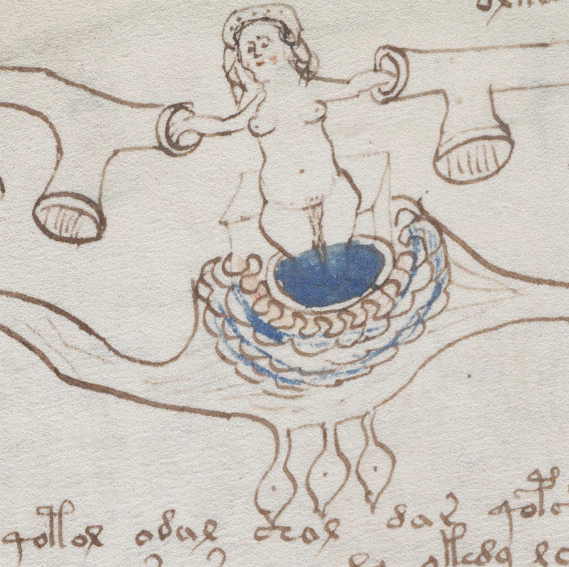 There are some pipe-like biological structures connecting various figures and the maiden is standing in some kind of “pool” (perhaps bodily fluids?) with three pendant shapes below her. At a glance, the image could be interpreted as a womb in the center with ovaries to either side, but could it mean something else, or have a dual meaning?
There are some pipe-like biological structures connecting various figures and the maiden is standing in some kind of “pool” (perhaps bodily fluids?) with three pendant shapes below her. At a glance, the image could be interpreted as a womb in the center with ovaries to either side, but could it mean something else, or have a dual meaning?
Diana or Sabine?
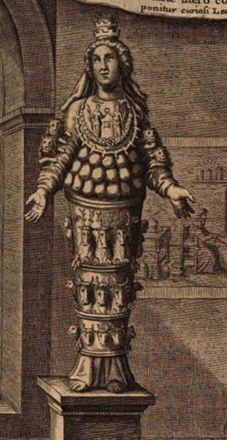 When I first saw this VMS page, it reminded me of two things. The first was the Ephesian Diana. I have a multitude of pictures of Diana and the evolution of her image from the early days of fancy necklaces to symbols of plenitude (acorns and possibly bull’s testicles) to the inevitable depiction of Diana with a multitude of breasts rather than testicles, ready to feed the world. The version of Diana at the Via d’Este displays a chest full of breasts. The image on the right, from one of Athanasius Kircher’s books, is not as clear, but might be testicles. The appendages under the central figure in the VMS could be interpreted as either testicles or breasts.
When I first saw this VMS page, it reminded me of two things. The first was the Ephesian Diana. I have a multitude of pictures of Diana and the evolution of her image from the early days of fancy necklaces to symbols of plenitude (acorns and possibly bull’s testicles) to the inevitable depiction of Diana with a multitude of breasts rather than testicles, ready to feed the world. The version of Diana at the Via d’Este displays a chest full of breasts. The image on the right, from one of Athanasius Kircher’s books, is not as clear, but might be testicles. The appendages under the central figure in the VMS could be interpreted as either testicles or breasts.
But… I wasn’t sure this was a metaphor for Diana, and the ejaculating phallus in the left-hand margin seemed to suggest something other than goddess worship (which was a sacred rather than a carnal adoration to many of the ancients). It’s possible this page is about procreation and insemination, fertility and abundance, as befits Diana, but maybe there’s another explanation…
A More Primal Interpretation
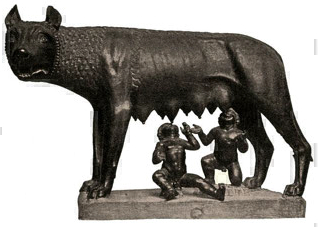 The second idea that came to mind at almost the same moment as the first was this… Could those pendant shapes represent animal teats and thus be a reference to Rome? They reminded me of the she-wolf suckling Romulus and Remus, the twins who had a disagreement over where to place their new city, an altercation that led to Romulus killing his brother Remus so he could have his way.
The second idea that came to mind at almost the same moment as the first was this… Could those pendant shapes represent animal teats and thus be a reference to Rome? They reminded me of the she-wolf suckling Romulus and Remus, the twins who had a disagreement over where to place their new city, an altercation that led to Romulus killing his brother Remus so he could have his way.
If the pendant shapes weren’t breasts or testicles as would be associated with the goddess Diana, could they be the teats of the she-wolf that fed Romulus and Remus? Is this a reference to the founding of Rome or to the capture of Rome in the 8th century BCE?
If so, then perhaps the VMS is allegorical imagery of the abduction of the Sabine women. I searched for a picture that might express the same ideas as the VMS, but in a more literal way and found this 18th-century painting by Jacques-Louis David:
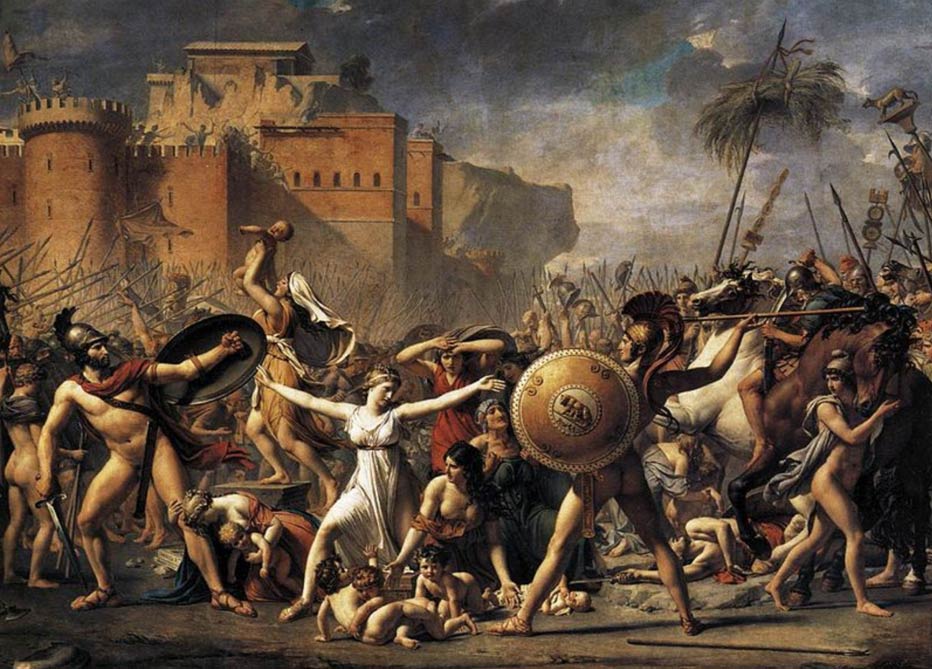 Note how the posture of the maiden trying to intervene in a battle somewhat echoes the arms-wide pose of the nymph in the VMS:
Note how the posture of the maiden trying to intervene in a battle somewhat echoes the arms-wide pose of the nymph in the VMS:
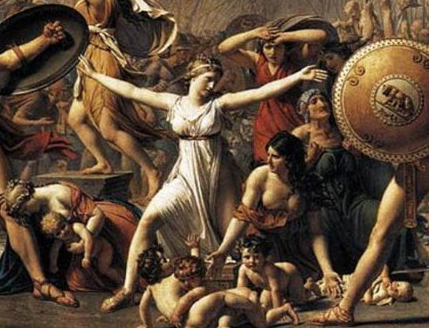 This might fit the VMS imagery more closely than the story of Diana. It could also explain the ejaculating phallus in the margin. Technically, the legend of the Sabines is about the abduction of the Sabine women, not the rape of the Sabines, but how often in history have warriors abducted women without an expectation of having sex with them, especially when they were kidnapping them expressly to take them as wives? Note also that two of the nymphs at the top are wearing veils. There are other places in the VMS where veils are associated with marriage-related imagery, but I’m not sure of their intended meaning here.
This might fit the VMS imagery more closely than the story of Diana. It could also explain the ejaculating phallus in the margin. Technically, the legend of the Sabines is about the abduction of the Sabine women, not the rape of the Sabines, but how often in history have warriors abducted women without an expectation of having sex with them, especially when they were kidnapping them expressly to take them as wives? Note also that two of the nymphs at the top are wearing veils. There are other places in the VMS where veils are associated with marriage-related imagery, but I’m not sure of their intended meaning here.
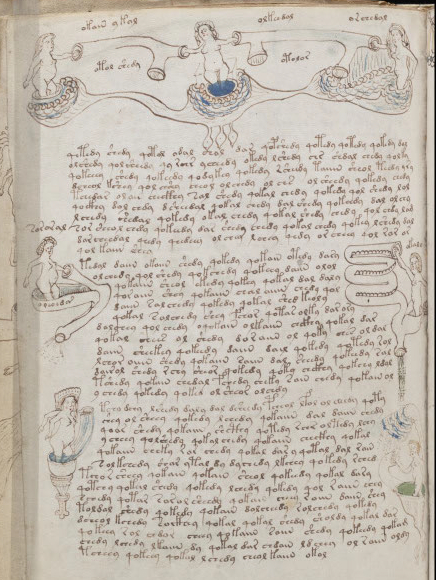 The story of the she-wolf and the founding of Rome might account for the dangly bits below the nymph’s feet (rather than being on her chest as might be expected if she were Diana) and the nymph with chin up and arms spread might represent the Sabine women who cast themselves between opposing forces, willing to die rather than to subject themselves to impious relationships with their kidnappers, an action that supposedly ended the battle and forged a truce between the Sabines and the new colonists.
The story of the she-wolf and the founding of Rome might account for the dangly bits below the nymph’s feet (rather than being on her chest as might be expected if she were Diana) and the nymph with chin up and arms spread might represent the Sabine women who cast themselves between opposing forces, willing to die rather than to subject themselves to impious relationships with their kidnappers, an action that supposedly ended the battle and forged a truce between the Sabines and the new colonists.
Either way, it’s another example of a page where biological imagery and mythical imagery might both be intended. If so, they are expressed in an obtuse but rather original way.
J.K. Petersen
© Copyright 2016 J.K. Petersen, All Rights Reserved

JKP! I keep running into things today that remind me of your posts. What do you think about this one? She’s sitting on a chair, which is a bonus. It might provide an answer for the two figures at her sides as well, especially the one on the right, who in the VM is standing in waves, just like Andromeda.
http://bildsuche.digitale-sammlungen.de/index.html?c=viewer&bandnummer=bsb00047183&pimage=239&v=100&nav=&l=de
Very interesting manuscript in general, by the way.
The fact that she’s sitting on something (perhaps a plinth, box, stair, or chair) might be an important detail considering it seems out of place next to the rounded “biological” structures (or nebuly, or whatever is going on there), so I’m glad you brought it up.
I’m not sure what it means in this context or whether it’s a box (like Pandora’s box), chair, or plinth holding a statue (we don’t know if she represents a living or mythical being so it could be a status of a goddess, for example), but nobility were often depicted on thrones or, since they were frequently on the move and often staying in encampments, on portable folding stools.
When it was a king, the portable stool often had lion-head knobs on the corners. The VMS box or stool is very plain in comparison to throne imagery, which is why I thought it might be a plinth, but… maybe it’s plain for some other reason.
Has anyone explored the theory that it’s a Seussian anatomy lesson for children? Complete with a nonsensical song that the children can learn and have fun with?
Perhaps ‘whimsical’ is a better choice than ‘nonsensical’…
I’m glad you mentioned constellations because the VMS fits the poses quite well.
Images of Andromeda with his/her arms tethered frequently have the arms outstretched as in the VMS central figure. Sometimes the constellation Cassiopeia is recycled (drawn twice)—once without wrist straps and then again with them to represent Andromeda. Sometimes Cassiopeia is sitting and sometimes standing.
So… how does this relate to the damsel in the VMS? I’m not sure. If the inspiration for this imagery is the constellations, then it’s possible the nymph represents both Cassiopeia (who is sometimes shown sitting) and Andromeda (usually tethered by the wrists). I can’t make out how the pendulous parts underneath relate to what is above but the possibility of both Cassiopeia and Andromeda being represented by one figure wouldn’t surprise me given that the VMS often hints at “dual-purpose” imagery.
I’ve been looking into this matter quite a bit, also in my latest blogposts I discuss a number of constellations. As you have probably noticed, Csssiopeia, her husband Cepheus and their daughter Andromeda are often depicted in succession or even on the same page. The manuscripts gathered in the Warburg institute website are especially clear about this. They also demonstrate that sex changes, though far from being the rule, are not uncommon either.
In that case, it suddenly becomes very much a possibility to see these three as Cepheus on the left, Cassiopeia in the middle and Andromeda on the right.
Cassiopeias attribute, before it became the mirror, was the throne. In some of those manuscripts, the throne isn’t much more than a box or some planks. The VM is very sparse with the items nymphs are allowed to interact with, so a box to sit on might as well be a throne.
What really sells it to me though, is that Andromeda was chained in the shallow water near the shore. And look at the ground the rightmost nymph is standing on. Waves.
What those three things are I haven’t found out yet either, but they seem too prominent to ignore. I don’t know whether they are part of the constellation layer, the narrative layer or the pipe structure though.
JKP – I was reminded of this post while I was reading about the Milky Way. The northern range of this “starry river” connects the constellations in the Cassiopeia group. Cassiopeia especially is the constellation full in the northernmost part of it.
Now, of course, there has always been a connection between the Milky Way and cow’s milk or breast milk. Also note that on the white structure on which the figures stand, and from which the “teats” hang, there are some lines drawn, as if it is a white flow.
This Cassiopeia identification is surely one of the strongest ones. Her exceptional position of facing the viewer and her being seated on something are aspects the nymph shares exclusively with the constellation. Also the spread, seemingly chained arms are similar. In fact, it seems so obvious that a number of people apparently noted this before I did, which shows that it’s not a product of my hunt for constellations 😉
So I wonder if this diagram tells about Cassiopeia as the northern point of the Milky Way, from which the stream seems to start and flow both ways. There are still a lot of questions, but I’m not as udderly confused anymore (lame pun intended). What do you think?
when I look at this page and the other pages depicting nude females, I keep thinking that the VMS is a medieval Midwifery manual for the lay people of the time. Based on medical practices of the time and the ritualistic practices of the midwife who was uneducated and learned the practice of midwifery from other experienced women. Also, the men of the era knew little about women’s health and things like menstruation, Conception and childbirth were shrouded in superstition, magic, and fear. Midwifes of the time believed many bizarre things about how women conceived and prescribed incantations, charms talismans and lots of other useless treatments for pregnancy and prevention of stillbirth. I have conducted some research on this theory and I will continue my efforts.
Hi, Ashley. I just learn about the Voynich Manuscript last week after watching a YouTube video by Thoughty2 posted Sep 4, 2020. Like you, when I first started looking at the illustrations I thought it was a women’s health manual. I was very disappointed when I realized it was not. Ignoring the plant pages, I think the Voynich Manuscript is about Ensoulment in the Aristotelian tradition. I think the star-flowers are souls.
https://collections.library.yale.edu/catalog/2002046
Beinecke Rare Book and Manuscript Library > Cipher Manuscript
Yale image 135 – page 75-right
The female “nymphs” in green liquid are semen leaving the male body and entering the female body. It’s not a spa. It’s a penis.
Yale image 138 – page 77-left
The illustration in the upper right shows a man scattering seed, symbolic of procreation.
The illustration in the upper left shows a “nymph” holding a plant; the first Aristotelian Soul – Plants or Vegetative Soul.
The next “nymph” below is holding what looks like a bird; the second Aristotelian Soul – Animals
Yale image 141 – page 78-right and Yale image 142 – page 79-left
Semen should be kept inside the male body where it will be safe as if behind a strong wall.
Yale image 144 – page 80-left
Note that the “nymph” in the upper left is holding a Christian cross. Semen in the male body is sacred.
Semen should only be released for procreation in marriage. Note that the second “nymph” on the left is holding a wedding ring.
If semen is released in another way then bad things will happen, possibly involving demons like at the bottom of the page.
Yale image 145 – page 80-right
The illustration on the middle-left may be a warning about going blind. We’ve all heard the myth about that. Some say that warning goes back to Aristotle.
Yale image 149 – page 82-right
The middle illustration shows the star-flower “soul” leaving heaven, or wherever pre-born souls exist, and entering the embryo in the female body.
The Monty Python “Every Sperm is Sacred” musical sketch was funny exactly because it was such a tradition. Monty Python didn’t create the story out of thin air. Surely somewhere there are historical documents in legible Latin on this topic.
As to why the “nymphs” in the semen are all female and not male or a mix of both genders, I can only speculate that the idea of having little naked male “nymphs” inside male bodies triggered homophobic fears.